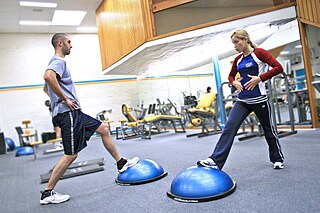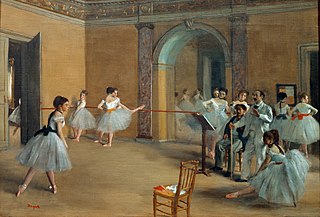
A personal trainer is an individual who creates and delivers safe and effective exercise programs for healthy individuals and groups, or those with medical clearance to exercise. They motivate clients by collaborating to set goals, providing meaningful feedback, and by being a reliable source for accountability. Trainers also conduct a variety of assessments beginning with a preparticipation health-screening and may also include assessments of posture and movement, flexibility, balance, core function, cardio-respiratory fitness, muscular fitness, body composition, and skill-related parameters to observe and gather relevant information needed to develop an effective exercise program and support client goal attainment.

Calisthenics or callisthenics (/ˌkælɪsˈθɛnɪks/) is a form of strength training that utilizes an individual's body weight as resistance to perform multi-joint, compound movements with little or no equipment.

Gōjū-ryū (剛柔流), Japanese for "hard-soft style", is one of the main traditional Okinawan styles of karate, featuring a combination of hard and soft techniques. Both principles, hard and soft, come from the famous martial arts book used by Okinawan masters during the 19th and 20th centuries, the Bubishi. Gō, which means hard, refers to closed hand techniques or straight linear attacks; jū, which means soft, refers to open hand techniques and circular movements. Gōjū-ryū incorporates both circular and linear movements into its curriculum, combining hard striking attacks such as kicks and close hand punches with softer open hand circular techniques for attacking, blocking, and controlling the opponent, including joint locks, grappling, takedowns, and throws.

William Edgar Thornton was an American NASA astronaut. He received a Bachelor of Science degree in physics from University of North Carolina and a doctorate in medicine, also from UNC. He flew on Challenger twice, the STS-8 and STS-51-B missions.
High-intensity training (HIT) is a form of strength training popularized in the 1970s by Arthur Jones, the founder of Nautilus. The training focuses on performing quality weight training repetitions to the point of momentary muscular failure. The training takes into account the number of repetitions, the amount of weight, and the amount of time the muscle is exposed to tension in order to maximize the amount of muscle fiber recruitment.
Distributed Interactive Simulation (DIS) is an IEEE standard for conducting real-time platform-level wargaming across multiple host computers and is used worldwide, especially by military organizations but also by other agencies such as those involved in space exploration and medicine.

Classical ballet is any of the traditional, formal styles of ballet that exclusively employ classical ballet technique. It is known for its aesthetics and rigorous technique, its flowing, precise movements, and its ethereal qualities.

Strength training, also known as weight training or resistance training, involves the performance of physical exercises that are designed to improve strength and endurance. It is often associated with the lifting of weights. It can also incorporate a variety of training techniques such as bodyweight exercises, isometrics, and plyometrics.

Arthur Allen Jones was the founder of Nautilus, Inc. and MedX, Inc. and the inventor of the Nautilus exercise machines, including the Nautilus pullover, which was first sold in 1970. Jones was a pioneer in the field of physical exercise i.e. weight and strength training. He was born in Arkansas, and grew up in Seminole, Oklahoma.

Plyometrics, also known as jump training or plyos, are exercises in which muscles exert maximum force in short intervals of time, with the goal of increasing power (speed-strength). This training focuses on learning to move from a muscle extension to a contraction in a rapid or "explosive" manner, such as in specialized repeated jumping. Plyometrics are primarily used by athletes, especially martial artists, sprinters and high jumpers, to improve performance, and are used in the fitness field to a much lesser degree.
Super Slow is a form of strengthening physical exercise popularized by Ken Hutchins. Super Slow is Hutchins' trademarked name for the High intensity training approach advocated by Arthur Jones. It is based on ideas from the 1940s and 1960s called 10/10 "muscle contraction with measured movement" and implemented using fixed weight Nautilus machines. In more recent times, such "Time Under Load" ideas have seen a renaissance with Dr Doug McGuff's best selling Body by Science.
Universal Gym Equipment was an American manufacturer of exercise equipment, in particular weight machines. It was founded by Harold Zinkin in 1957. In 1998, it was acquired by Flexible Flyer. In 2006 it was acquired by Nautilus, Inc. The Universal Gym brand was subsequently discontinued except for a line of selectorized dumbbells.

The following outline is provided as an overview of and topical guide to exercise:

Orthopedic pathology, also known as bone pathology is a subspecialty of surgical pathology which deals with the diagnosis and feature of many bone diseases, specifically studying the cause and effects of disorders of the musculoskeletal system. It uses gross and microscopic findings along with the findings of in vivo radiological studies, and occasionally, specimen radiographs to diagnose diseases of the bones.
Aquatic therapy refers to treatments and exercises performed in water for relaxation, fitness, physical rehabilitation, and other therapeutic benefit. Typically a qualified aquatic therapist gives constant attendance to a person receiving treatment in a heated therapy pool. Aquatic therapy techniques include Ai Chi, Aqua Running, Bad Ragaz Ring Method, Burdenko Method, Halliwick, Watsu, and other aquatic bodywork forms. Therapeutic applications include neurological disorders, spine pain, musculoskeletal pain, postoperative orthopedic rehabilitation, pediatric disabilities, and pressure ulcers.

The Bruce protocol is a standardized diagnostic test used in the evaluation of cardiac function and physical fitness, developed by American cardiologist Robert A. Bruce.

The Colorado Experiment was a bodybuilding experiment run by Arthur Jones using Nautilus equipment at the Colorado State University in May 1973.
Sport psychology was defined by the European Federation of Sport Psychology (FEPSAC) in 1996, as the study of the psychological basis, processes, and effects of sport. Otherwise, sport is considered as any physical activity where the individuals engage for competition and health. Sport psychology is recognized as an interdisciplinary science that draws on knowledge from many related fields including biomechanics, physiology, kinesiology and psychology. It involves the study of how psychological factors affect performance and how participation in sport and exercise affect psychological and physical factors. Sport psychologists teach cognitive and behavioral strategies to athletes in order to improve their experience and performance in sports.
A communication protocol is a system of rules that allows two or more entities of a communications system to transmit information via any variation of a physical quantity. The protocol defines the rules, syntax, semantics, and synchronization of communication and possible error recovery methods. Protocols may be implemented by hardware, software, or a combination of both.
A strength and conditioning coach is a physical performance professional who uses exercise prescription to improve the performance of competitive athletes or athletic teams. This is achieved through the combination of strength training, aerobic conditioning, and other methods.










